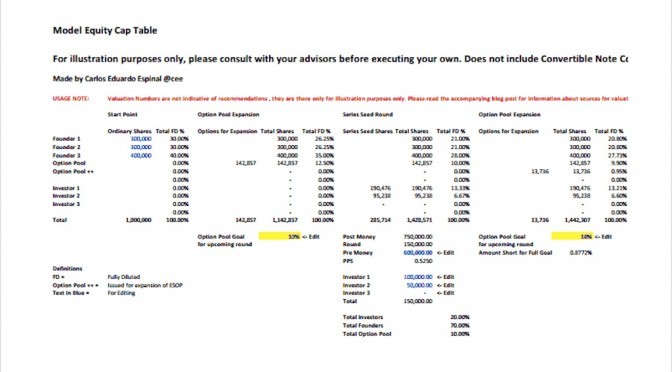Investment – Are You in Danger of Raising a Toxic Investment Round
Post on: 12 Август, 2015 No Comment

Fundraising for an early stage technology startup is always a challenge . You have to navigate many meetings with potential investors and hopefully reach agreements that make everyone happy so you can continue to work in good faith after the negotiations are over. However, in some cases, after the dust has settled in a negotiation, it isn’t always a win-win for everyone.
For example, what do all the following company circumstances have in common? (note: all these companies are real early stage companies.)
- A founder who gave away > 60% of his company for 100K in funding in tranches.
- A founder that gave away > 75% of his company to his ‘investors’ in a pre-series A round.
- A company that gave away > 70% of their company for < 100K to investors, but still wanted to go through an accelerator.
- Another company with 51% ownership to existing investors .
- Another company where the investor offered the founders a sub €30K investment but it came over tranches across the year (as in no cash right now).
As you read the above examples, you might find these offers as ’normal’ (then this post will hopefully help you think twice in the future about these kinds of deals), or you might reel in shock as you read each one of the above anecdotes. Either way, in this post I want to highlight the concept of a ‘Toxic round’ or a ‘Toxic cap table’ in an early stage startup to help founders navigate potential investment offers and avoid getting themselves into a difficult situation in the future.
What is a ‘toxic’ round?
‘Toxic’ rounds (not a technical term) can be defined as fundraising rounds that can pre-dispose a company to struggle to find subsequent financing because newer investors shy away from a potential investment once they find out what the state of the company’s current cap table and or governance.
Whilst it is very hard to make any judgments about the quality of investors because each company’s financing history is unique, a common view is that investors that ask for terms such as those highlighted above are usually not of the sort that one wants to take investment from. However, the focus of this post isn’t to highlight the qualities of ideal investors (if you want to read more about the ideal qualities of a new investor check out this text ), but rather why subsequent new investors might shy away from investing in your company if you have taken on this kind of round in the past. Additionally, in this post I’m only focusing on founder dilution and not on other potential aspects of a company’s shareholdership that could make it difficult for new investors to invest.
Therefore, the reasons why a new investor might shy away from a company that has experienced a ‘toxic’ round in the past can include:

- Because the company will likely require more capital in the future should it prove successful, and potential new investors feel that the founders will be less motivated to stick with the company as the value of their equity declines over time through premature excessive dilution.
- New potential investors feel that current investors own too much of the company and perhaps the company has a governance issues as a consequence.
- Because the investors have a large stake, it brings up a lot of questions about how the company got itself into this situation. Did it happen through a down-round? Was it due to other negative circumstances which could affect the future of a new investment? The circumstances raise a lot of questions and doubt in a new investor, and considering how many investment options an investor receives per year, frankly, as a founder raising capital you just don’t need any more reasons for a new investor to reject you.
- In the specific case of ‘debt’ or an ‘early exit of existing investors as part of a new financing’; potential new investors can sometimes object to having the money they are putting in as part of a new round be used for anything other than to expand the growth of a company. This means, potential new investors may shy away from companies that have investors that are eager to dump their shares as part of the financing transaction or companies that have too much debt outstanding that is repayable as part of an upcoming round.
Having said the above, how do you more precisely define a toxic round? Well, a toxic round could be where either “too much money” comes in too early at a too low a valuation, or where a company is too under-valued, or both. All of these cases lead to founders being greatly diluted too early in their company’s life.
To help you visualise these potential scenarios, let’s look at the following equations:
- Money Raised / Post Money = % dilution to founders
- Money Raised / (Pre Money + Money Raised ) = % owned by the new investors
These two equations represent the same thing. the only thing that changes is the definitions, but the numbers are all the same. If you don’t know what Pre or Post money mean, check out myrecent blog post which defines some of the components of a round.
What is the solution for toxic rounds?
Knowing the above, it would seem that the solution for toxic rounds would include both raising the right amount of money AND setting the right valuation for the company early on so that as the company grows, it doesn’t find itself in a ‘toxic’ situation. If you want to read more about how much money to raise and setting the right milestones check out my following posts below:
So if that solves the ‘Money Raised’ part of the equation, how about the valuation parts of the equation (pre-money)? Valuing an early stage company is always a source of much debate and causes many people lots of stress. As I’ve described on my previous blog posts on the subject:
There are many methods one can take to arguably ‘price’ a company. However, the larger point is that no matter what method you use, it will always be subject to current market dynamics… meaning that no matter what “quantitative” method you think you are using, it is subject to the variability of how the overall market is trending… if we are in a boom, the pricing will likely be higher, if we are in a bust, it will likely be lower. It’s a simple as that.
Taking these market dynamics in consideration, take a look at a recent Fortune blog post on what the average dilution hits are in the USA for Series Seed, A, B, and C rounds. In the Fortune post, you can see the average dilution per round for the typical rounds and you can see the market dynamics over the years (check out what the 2007 recession did to % dilution per round). What you realise is that none of these rounds, no matter how big, take as much equity as the real life examples I noted above at the start of this post. Even if you consider that different countries have different country risks, the range of numbers is a multiple of 3x what is recorded over the last 6 years in the USA.
What if your investment round was toxic?
So what if you’re already in a tricky situation similar to the examples I noted above? If you find that you are in the situations described in this post, unfortunately the available solutions aren’t always easy and straightforward. The single best solution is to have a tough talk with existing investors on how to rectify the situation before new investors either walk away or make it conditional as part of their new investment. There can be many ‘creative’ solutions to solving the problem with your investors, such as investors giving back equity if founders hit milestones, but they will all seem ‘creative’ to a new investor rather than ‘clean’ if not completed before they invest; hence why the ideal solution is to work through this topic with existing investors and help them understand that by not helping you overcome the situation, they very well may be jeopardising the long term value of their own investment. Perhaps counter-intuitive, but true. In the end, any progress you make with existing investors on fixing these situations if you are already in them, is better than no progress, no matter how tough the discussions.
I leave with you with the following thought of prevention for you to discuss with your potential new investors if they offer you a hard deal… yes, they are taking a huge risk by investing in your early stage startup, but by taking too much equity or debt too early, are they really just pre-disposing your company to failure? Something to discuss.














